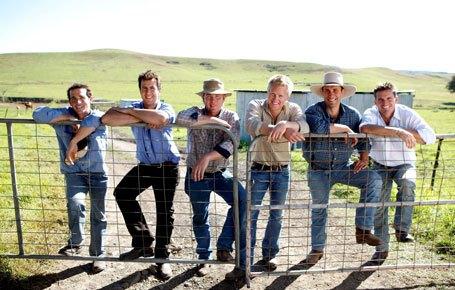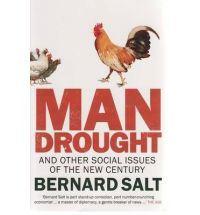
Channel Nine’s hit reality show Farmer wants a wife was based on fact … there are more single men in rural Australia than in the cities.
Man drought. These two simple words can strike fear into the hearts of most 30-something single women.
Not because we aren’t happy being single *cough, cough*, but because when push comes to shove, the prospect that there may not be enough fellas to go around tends to induce a slight panic attack. (WTF. Are you serious? What do you mean there’s a man drought? They must be somewhere!)
And suddenly the ticking of one’s biological clock, which was an easy-to-ignore gentle hum turns into a loud and persistent pounding.
But does the man drought really exist or is it all a fallacy? A handy excuse we throw out when pressured to find a mate, settle down and pop out a couple of kids?
Renowned Australian demographer and social commentator Bernard Salt found himself discussing Australia’s single scene so frequently that in 2008 he released his third book, Man Drought, based on the 2006 Census results. 
His study revealed there was less product for 30-something women to choose from, with the number of single women outweighing single men.
“It was pre-Global Financial Crisis (GFC) and the situation then was that, at an aggregate level, there was actually a low-supply of men in their late 20s and early 30s across Australia,” Salt said.
“I put (the drought) down to high levels of Gen X and Gen Y working overseas; if they were in property, construction or engineering, they went to the United Arab Emirates (UAE); if they were in finance, they went to London or New York and those in IT headed to either Silicon Valley or Mumbai,” he explained.
Salt also looked into the UAE’s Census which showed there were close to 20,000 Australians working in Dubai at the time—most of whom were single men aged between 25 and 40 years.
“That diminution of men in their late 20s and 30s was further exacerbated by distribution matters—most of the single men were concentrated in rural and remote communities whereas the single women were in the city and lifestyle towns in sea-change and tree-change communities,” Salt said.
“There are very basic things that drive the partnering process but recent changes in men and women’s circumstance, education and aspirations are changing the rules and throwing up this issue of the ‘man drought’.”
“Thirty years ago, a young woman living in a country town like Gundagai grew up and married the fellow next door but these days she wants to go to university or attend further education/training in the city.”
That migration throws out the gender balance.
“These women don’t go to Ipswich, Beenleigh or Caboolture, they go to New Farm, West End, Spring Hill and Woolloongabba—the cool places in the inner city and then wonder where all the men are … well, they’re back in Cootamundra and areas like that.”
“The bachelor hot spot for Brisbane is Upper Mt Gravatt where there are two single men to every single woman.” —Bernard Salt—
The 2011 Census showed that while the stats on singledom haven’t greatly changed since 2008, there is more ‘product’ on the man market following the GFC.
“When the men started coming home in 2008/2009, I suggested that single women position themselves between the Arrivals Hall and the car park at Sydney International Airport,” Salt joked.
Despite this influx, men and women are still living—and moving—in different circles.
“Maybe women need to change their geography, but I would also say that men in search of a partner might want to change their geography too and spend a few weekends in the city.”
But there must be some men in the city, right?
According to Salt, the place to be in Brisbane is Upper Mt Gravatt, where the odds are 2-1.
“There are two single men to every single woman; it’s also right near the university and there are a lot of foreign students who come out to study there, which is why those numbers are high,” Salt said.
Lakemba in south-west Sydney and West Footscray in Melbourne are also hot spots for single men.
But as someone once joked, the odds are good but the goods might be odd … and the lack of ‘quality’ men is also a common complaint among successful career women.
“Millions of years of evolution mean women are hard-wired to ‘marry up’,” Salt explained.
“The male must be taller, stronger, fitter and earning more and this usually means they will be slightly older and more established.
“It might sound very gold-diggerish but it’s evolution talking; women who chose a weaker, smaller, younger mate died off half a million years’ ago.”
But with more women than men now graduating from university, is it getting harder to find a man who meets those ‘evolutionary’ requirements?
“Yes it is; in the fields of law, finance and engineering there are women moving up the income hierarchy but, despite this advancement, they are still hardwired to ‘marry up’, so if she’s a GP, pharmacist or fund manager, how many available men are there?” Salt said.
“The truth is there aren’t many and this is why they need to change their geography and go out to places like Cootamundra or Gilgandra.
“They also need to change their expectations of what they want in a partner because he may not wear a suit,” Salt said.
“Women really seem to struggle with that; they know it’s politically correct to accept that a suitable partner may not wear a suit and they’re happy for others to accept it, but then they say ‘but not for me, I like a suit’.”
Brisbane’s Table of Six franchisee Bonnie Davidson backs up Salt’s findings, but blames the mining boom in Central Queensland for the ‘man drought’.
“We definitely have a man drought in the city but we also now have a number of ‘man towns’ in Central Queensland such as Tieri, Emerald and Mt Isa,” she said.
The latest figures released by online dating giant, RSVP, also support the rural swing, with singles of both sexes, living in regional areas leading a surge in online dating. 
“Across Queensland, the growth of new members from regional areas was more than six per cent, whereas the growth in members from Brisbane was around five per cent,” RSVP spokesperson Melanie Dudgeon said.
The strongest growth came from Toowoomba (12 per cent), Cairns, Rockhampton and Townsville (11 per cent) and Mackay (nine per cent).
“We know singles in regional areas can feel limited in their dating options because they live in smaller communities where there are less prospective partners to choose from,” Melanie said.
“Online dating provides a way to engage with new singles who are outside your immediate location or existing social network and this is why regional Australian singles are signing up to RSVP.”
But it’s not all bad news, city dwellers—because when the boys are back in town, they are often on the lookout for love.
“Many of our clients fly in/fly out but when they join us they are goal-focused to find a lady; they dine more frequently and want us to organize their social lives,” Bonnie said.
“Men join Table of Six for varying reasons at different ages, but as a bit of a guide we normally find that those aged 25 to 45 years are looking to settle down and have children, while those aged 40 to 55 years are often newly divorced and wanting a social life.
“Then there are those aged 50 plus who want to settle down again, second time around.”
Now that we know where the men are, the question is … how do we get in touch with them?
Social media seems the obvious answers—especially when 83 per cent of RSVP survey respondents claim it’s not easy to find someone out on the town—but opinions vary on whether the new forms of media are helping or hindering our love lives.
“I think social media hinders as many people will discount without ever meeting people,” Bonnie said.
“I meet everyone at our dinners and people constantly surprise me with how much more they are than what is on paper.
“Nothing beats meeting a person face to face—you see the real person with their own individual personality not just a paper profile or photo.”
So, who now fancies a trip to the Roma Races or the Mt Isa Rodeo?
Editor’s note: This story was first published on Here & Now—an awesome new online national magazine which aims to support, inspire and celebrate women (and I’m not just saying that because I’m one of their feature writers). Go on, check it out!
